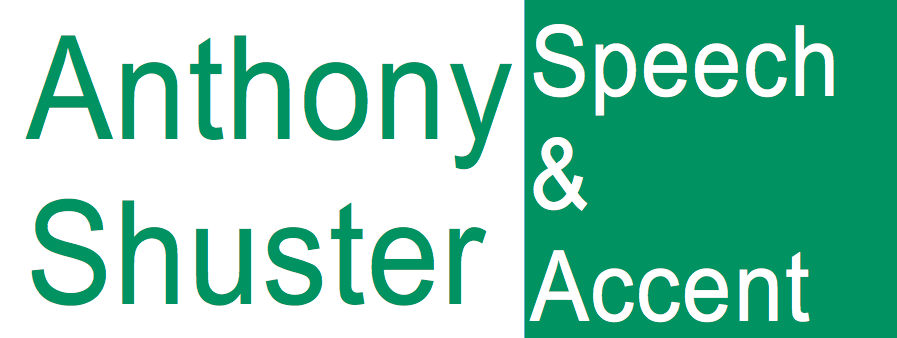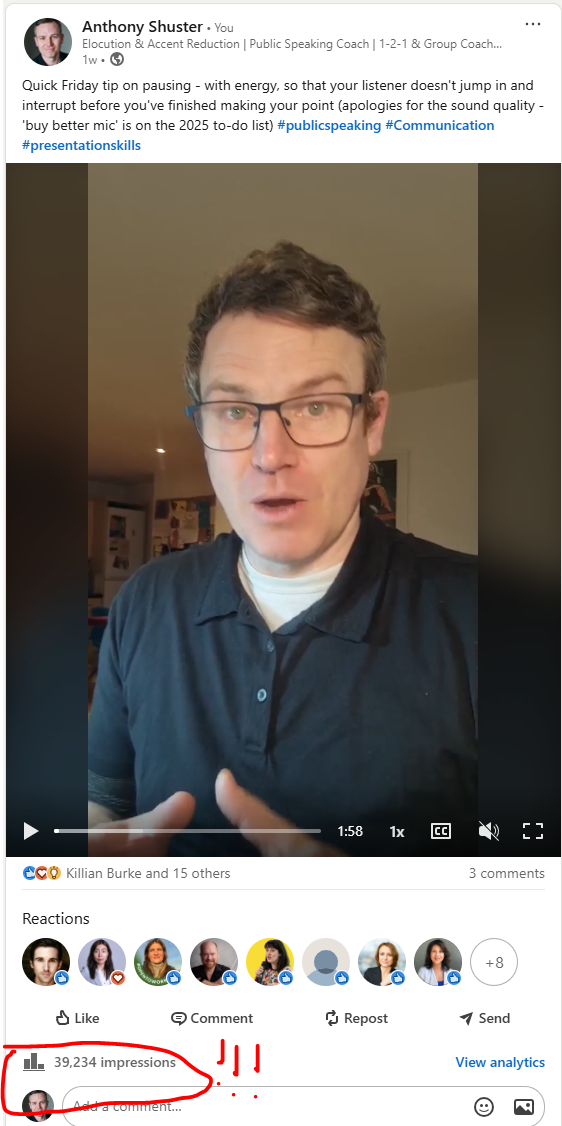Mastering the Power of Pauses: Enhance Your Communication, Presentation, and Storytelling Skills
Going viral: here’s me on pausing… paused. The biggest ripple I’ve made in the LinkedIn pond so far
I posted a video on LinkedIn the other week, that's been going kind of viral: it's about how to pause, with energy, so that listeners don't take your pause as their cue to jump in and interrupt you.
It's been seen by tens of thousands of users (rather than my usual several hundred close friends) , so I thought I'd follow up with some thoughts on pausing.
I've written recently about what pauses are really for: not for 'dramatic effect' but to help the listener to take in what you've said and get ready to hear more. This way, we reduce the amount of effort and work required from a listener - and who doesn't like to work less hard, eh?
For effective communication, the power of a well-placed pause almost cannot be overstated.
When you give your listener time to absorb each valuable nugget of information or inspiration you have to share, it enhances clarity in a similar way to vivid vocal emphasis.
If we pause to allow a thought to really be heard, It's almost like we put a frame around it.
Pausing in Action: Lessons from the Greats
What sets accomplished speakers apart is their ability to use pauses consciously and deliberately. For instance, in a business setting, pauses can make your presentation more impactful by giving your listeners time to receive your crucial points- and this serves to highlight them.
Pauses also convey a sense of VALUE: when we listen to a speaker who speaks at the pace at which we think, it makes us feel seen and valued. So the speaker gives an impression of confidence and control, essential traits for authentic presence development.
In other words, leaders seeking CEO communication coaching learn to use pauses to hold attention, and holding attention conveys a sense of authority. When combined with powerful storytelling techniques, pauses help you connect emotionally with your audience, and that leaves a lasting impression.
Pause master: Barack Obama. Obviously.
In my last post on pauses, I talked about how former U.S. President Barack Obama is a master of this technique.
His speeches are marked by deliberate pacing and well-timed pauses, which draw in his audience and underscore the significance of his words.
In my LinkedIn post, I refer to the way British prime minister Winston Churchill, whose wartime addresses are famous for their determination and gravity, making his messages both impactful and unforgettable.
Similarly, Martin Luther King Jr.’s “I Have a Dream” speech stands as a testament to the power of the pause. (I referenced the great MLK Jr in another video post last week, about the impact of upspeak: one for another article, I think. Must stay on topic!)
Each break allowed Dr King's visionary ideas to resonate deeply; it's partly why he leaves suc an indelible mark on listeners.
Martin Luther King: depicted here, pausing
Why Pausing Matters for Dealing with Nerves
I'm always reminding the people I work with that in order to achieve effective communication we should think about pausing as something we do for the listener: a pause creates space in which to process information, so your thoughts are more digestible. Then listeners can pick up on their value.
But a pause is useful for the speaker too: it provides a moment to breathe, find the words to express your thought. This is how you maintain your composure and manage your nerves.
If you can keep breathing, and stay focused on your next thought, you won't feel like you're rushing through your delivery - even though you're speaking with energy.
And when you do pause, you can then pause with energy - because you know where you're heading, and you're in control. You're not using the pause because you've got flustered, and momentarily run out of things to say.
It's at those moments when audiences tend to assume the speaker has lost her place, or got distracted, or in conversation, it's when the other person takes their cue to jump in and cut you off.
This is what my LinkedIn video is all about - watch it here (have I linked to it often enough? Haha)
Whether you are engaged in elocution lessons in London or presentation skills training, understanding how to incorporate pauses into your speech can elevate your effectiveness as a communicator.
Pausing. Between. Bullet. Points.
Everyone (according to Google anyway) loves bullet points and step-by-step guides so lets repackage this for those who are skim-reading:
Pause Before Each New Point: pauses allow your audience’s attention to refocus for what's coming next. This technique is particularly effective during 'public' speaking events like presentations and workshops, that aren't on the small intimate scale of a one-to-one conversation.
OR: Pause After Each New Point: Allowing silence after a critical statement gives your audience time to reflect and absorb the information.
Pauses Help to Eliminate Filler Words: Filling silences with “um” and “uh” can detract from your credibility because it makes the listener work: they have to filter out the meaningless noises you're making from the meaningful thoughts. Use a pause to make time to gather your thoughts, instead of an 'um' to buy you time: it supports effective communication, which in turns projects confidence and authority.
Pause to Channel your Nervous Energy - Don't Just Slow Down: Deliberate pauses prevent you from speaking too quickly, ensuring that your message is clear and impactful and conveys VALUE. This is a core principle we work on in the communication coaching and presentation skills training I offer.
How to Practise Pausing
Incorporating pauses into your speech requires practice and intentionality. Here are some tips to help you get started:
Rehearse with Intentional Pauses: Practice your speech or presentation, deliberately pausing in between each new thought, or new bite-sized piece of information. We go into this in detail in my free 1hr online taster session. Over time, this will become a natural part of your delivery.
Record Yourself: Listening to a recording of your speech can help you identify areas where a pause could enhance your message.
Work with a Coach - me!: in my communication coaching and elocution lessons I provide personalised feedback on your use of pauses, helping you to refine your delivery.
Bring me in to run a Workshop: running a communication workshop or storytelling course for your team can give them hands-on experience in mastering this skill.
The Business Case for Pausing
For professionals, mastering the pause can have significant career benefits. Whether you’re presenting to a boardroom, leading a team, or delivering a keynote address, the ability to pause effectively can enhance your leadership presence. CEO communication coaching often emphasises the importance of pausing to convey authority and inspire trust. Similarly, presentation skills training teaches professionals to use pauses to make their messages more memorable.
Pauses are relevant for overall speech clarity too: in elocution lessons and accent reduction classes, students learn that pauses can improve pronunciation and clarity, essential for non-native speakers or those looking to refine their accents.
Resources to Enhance Your Skills
If you’re looking to improve your communication skills, there are different ways to do that with me, depending on what you need. But all my tailored courses in accent reduction, elocution, and presentation skills training are designed to help individuals harness the power of the pause and other essential techniques.
For more insights into effective communication, check out some of my recent articles:
‘Dramatic pause’? Here’s the Real Reason Pauses Matter in Public Speaking
Does Public Speaking Have to Be Surprising to Be Interesting?
Masterclass: How to Speak Well and Move People (Try the Exercise at the End)
Pauses are powerful but most speakers don't pause often enough - maybe just enough to snatch a quick breath. In a free 1-hour taster session, we can look at what accomplished speakers do - when do they pause, how often, with what kind of energy. And rather than just talking about it, we'll actually do it. We'll practise intentional pauses, so you can enhance your communication, presentation, and storytelling skills.
Whether you’re pursuing authentic presence development at the start of your career, or you're in the C-suite now and need to take your communication coaching to CEO level, the ability to pause effectively can set you apart as a confident and compelling speaker. So, take a breath, give them a moment, and let your words truly resonate.



